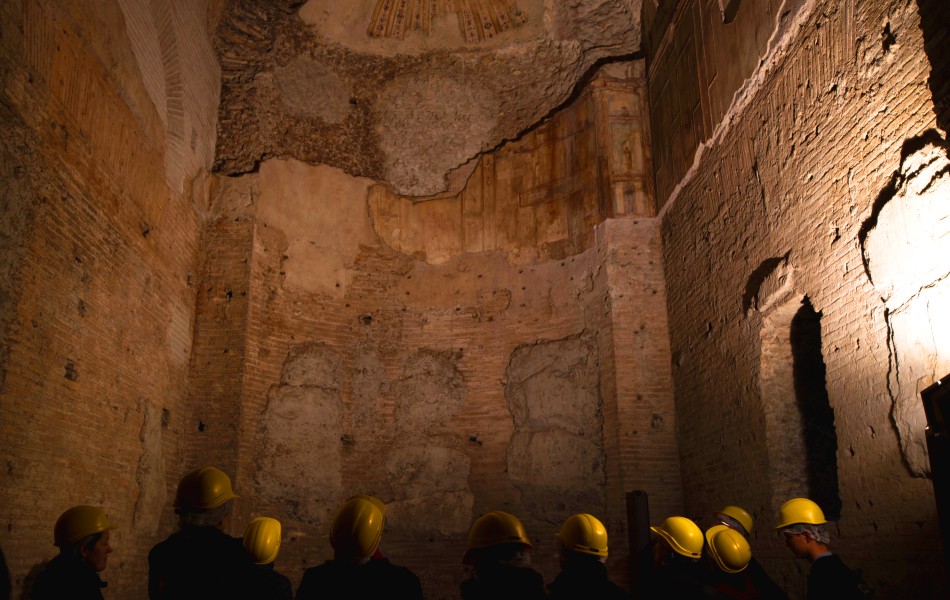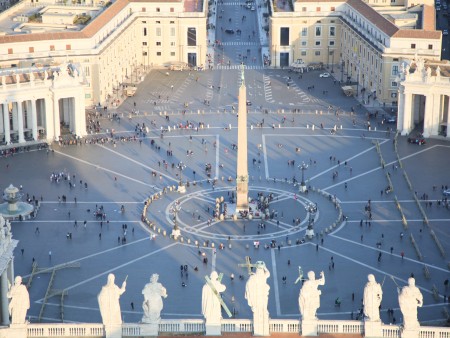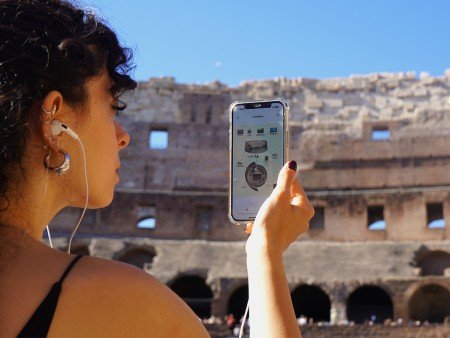Domus Aurea: the imposing palace of Nero's Golden House with astonishing frescoes
Nero's Domus Aurea and its historical legacy from Ancient Rome till the Renaissance

06 June 2024
Rome Travel GuideThe Domus Aurea, which literally translates to the "Golden House”, was a massive villa complex built by the last emperor of the Julio-Claudian dynasty, Nero. The villa itself symbolizes a great shift in ancient Rome, the transition from a republic to an empire, from elected consuls to authoritarianism. Furthermore, the Domus Aurea is a particularly unique edifice because it only stood for a couple years until successive emperors re-converted parts of the complex into new monuments, like the Colosseum and Domitian’s Palace on the Palatine hill.
The Transformation of Rome: From Republic to Empire under Augustus and Nero
To truly understand the significance of the Domus Aurea we need to take a few steps back to when Rome was still a republic in the 1st century BC. A series of power hungry individuals, like Sulla and Julius Caesar, inevitably led the republic into a series of civil wars, which rocked Rome to its core. Amongst the confusion Octavian, later renamed Augustus, arose from the tumult and became the first emperor in 27 BC. The reasons behind this shift in government are multiple, but Rome ultimately became what she had repudiated for centuries, an empire whose rulers were no longer elected by a part of the population, but an empire, where blood was the most important trait to becoming leader of the res publica. This transition also came with topographical changes to the city, from being a city without a continuous building policy due to the fact that consuls were only in power for a year at a time, and thus used the short time they had in office to sponsor monuments that would ultimately lead to aggrandize their own name, now emperors, whose reigns were longer, could totally re-shape the city to their liking. In fact, Augustus is credited with saying “I found Rome built of bricks, I leave her clothed in marble.” Due to his long reign (27 BC-14 AD), Augustus was able to rebuild and renovate the city into what many of us imagine it today: a grandiose and luxurious ancient city with grand and imposing monuments. Nonetheless, certain areas of the city center, which housed the city’s elites were left untouched to not create further agitation in the patrician classes, who, at least in part, supported a return to a republic.
Nero, Augustus’ great, great grandson came to power in 54 AD. Nero’s reign is hard to decipher since much that was written about him were works of ancient propaganda intending to discredit him, and thus must be taken with a grain of salt. Rising to the throne at only seventeen years old it is understandable that he may not have been particularly prepared for the most important job on the planet. Many ancient historians have mixed opinions of the young emperor from Pliny the Elder to Josephus, from Suetonius to Tacitus. Some are particularly damning, while others make no mention of the grave accusations that other contemporary writers pronounce. Nero is credited with a wide variety of heinous crimes, from killing his own mother, to raping a Vestal virgin (a big no-no in ancient Rome), to forcing audiences to endure his day long theatrical and musical performances and so on. Two-thousand years later it is particularly hard to discern fact from fiction, but what we can say for sure is that Nero was an especially hated ruler. In part due to his character, but also due to certain republican factions wanting to portray the emperor as tyrannical as possible to pursue their goals of re-establishing Rome as a republic.
The Mystery of the Great Fire of Rome in 64 AD
One of the most infamous depictions of Nero is surrounding the episode of the Great Fire of 64 AD. Fires in ancient Rome were a particularly common occurrence since the majority of plebeian apartment blocks were made out of wood and fire was used for cooking and heating. It was very common for fires to break out in these poor neighborhoods and then disperse into the rest of the city. A important piece of evidence for this threat is the wall that divides the Suburra (modern day Monti) with the area of the fora, which was built not only to contain people, but also fires. According to ancient sources, on July 18th 64 AD a fire broke out, which burned for over ten days and nights, destroying an enormous part of the ancient city. Some historians, like Tacitus, claim it was an accident and that Nero had nothing to do with it, since he was away in his summer retreat in Antium, a small beach town south of Rome. While others are a lot more damning, claiming Nero had his men start the fire on purpose, and others go so far as to say that while Rome burned Nero celebrated by playing the lyre from a hilltop outside the city, watching from afar in glee as the city burned. What happened that night we will never know, but what we do know is what Nero decided to do in the aftermath.
Nero's Golden House: A Symbol of Luxury and Power in Ancient Rome
With all this new land that was cleared in the heart of the city, Nero decided to build an enormous villa complex for himself, expropriating many of the noble patricians from their ancestral homes. This villa complex today is hard to imagine, but it must have looked something like Hadrian’s palace in Tivoli or the ancient hanging gardens of Babylon. A large multi-structure villa with elaborate gardens, an artificial lake, a private bath complex, statues from various temples across the empire, built to host the most extravagant banquets and lavish entertainment the ancient world could offer.
To visit it, it is advisable to book a tour of the Domus Aurea in advance.
The most famous particularity of the structure was the round feast room on the Colle Oppio, which was said to be continually rotating, like the universe, so that the guests could view different parts of the sky through an oculus in the ceiling as the banquet proceeded. It was the definition of opulence and excess, and Nero spared no expense. The villa spanned 219 hectares to be exact, comprising portions of the Palatine, Esquiline, and Caelian hills, as well as the valleys in between.
The villa was likely never finished and shortly after Nero’s death some of the land was given back to its original wealthy patrician owners, while the rest was used for other building projects. For example, the Flavian Amphitheatre gets its nickname, the “Colosseum,” from the colossal statue of Nero that was reconverted to the sun god Apollo that stood in front of the arena. The site of Rome’s most world-renown monument was the location of Nero’s private man-made lake. Due to this rapid re-transformation of the city only a small part of the Domus Aurea remains, located on Colle Oppio. Even where exactly the structure was located is up for debate, as the location of most monuments in ancient Rome. In roughly 40 years the entirety of the Domus Aurea had vanished under other constructions. However, due to it being built over and covered by sand and gravel a lot of the frescos in some of the rooms stood the test of time. Starting in the 15th century when the lost rooms were stumbled upon by chance, the beauty of the Domus Aurea resurfaced. Even some famous Renaissance painters, such as Pinturicchio, Raffaello, and Michelangelo saw the newly excavated remains. Discoveries, however, did not stop there. Even in May 2019 another room was unearthed, called Sala della Sfinge, with extremely well preserved frescoes depicting the God Pan, panthers, and a sphynx. As time goes on and our technological abilities increase it is likely that new developments regarding the Domus Aurea will emerge.
Our categories:
You may also be interested ...

Vatican Private Tour with Sistine Chapel & St. Peter's Basilica: Renaissance’s Wonders
Private tour
Discover with a skip the line Private Vatican Tour the Sistine Chapel, Vatican Museums and St Peter’s Basilica
starting from: € 375

Colosseum Guided Audio Tour with Roman Forum and Palatine Hill
Private tour
Discover Ancient Rome’s secrets and history with our immersive Colosseum guided audio tour, rich in image and content
starting from: € 51 € 42